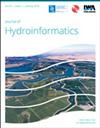Study on the influencing parameters of rough-strip energy dissipators of curved spillways based on orthogonal tests and numerical simulation
IF 2.2
3区 工程技术
Q3 COMPUTER SCIENCE, INTERDISCIPLINARY APPLICATIONS
引用次数: 0
Abstract
Abstract Rough-strip energy dissipators (R-SEDs) can be arranged at the bend bottom of curved spillways to dissipate energy and divert flow for bend flow. Using the entropy weight and TOPSIS methods, a multi-criteria evaluation system was established for comprehensive energy dissipation and flow diversion effects of R-SEDs. Orthogonal tests and numerical simulation were conducted to analyze factors affecting these effects (average R-SED height, R-SED angle, R-SED spacing, bend width, bend centerline radius and discharge flow rate). It was found that bend width and bend centerline radius significantly affected R-SEDs' energy dissipation effects. Average R-SED height, R-SED spacing and bend centerline radius significantly affected R-SEDs' flow diversion effects. Bend width, average R-SED height and bend centerline radius significantly affected R-SEDs' combined effects of energy dissipation and flow diversion. Their energy dissipation effects were larger than the flow diversion effects. R-SEDs can effectively alleviate adverse hydraulic phenomena in curved spillways. With the recommended parameters, R-SEDs showed the best performance, with the energy dissipation rate increasing by 18.67% and the water surface superelevation coefficient decreasing by 26.14%. The accuracy of the multi-criteria evaluation system was verified. This study can provide a reference for the R-SED design of similar curved spillways.基于正交试验和数值模拟的弯曲溢洪道粗条消能器影响参数研究
摘要在弯曲溢洪道弯道底部布置粗条形消能器,对弯曲水流起到消能分流的作用。采用熵权法和TOPSIS法,建立了R-SEDs综合消能导流效果的多指标评价体系。通过正交试验和数值模拟分析了影响这些效果的因素(平均R-SED高度、R-SED角度、R-SED间距、弯道宽度、弯道中心线半径和流量)。弯曲宽度和弯曲中心线半径显著影响r - sed的耗能效果。平均R-SED高度、R-SED间距和弯道中心线半径显著影响R-SED的导流效果。弯道宽度、平均R-SED高度和弯道中心线半径显著影响R-SED耗能和导流的综合效果。它们的能量耗散效应大于导流效应。R-SEDs可以有效缓解弯曲溢洪道的不利水力现象。在推荐参数下,R-SEDs性能最佳,耗散率提高18.67%,水面超高程系数降低26.14%。验证了多准则评价体系的准确性。该研究可为类似弯道的R-SED设计提供参考。
本文章由计算机程序翻译,如有差异,请以英文原文为准。
求助全文
约1分钟内获得全文
求助全文
来源期刊

Journal of Hydroinformatics
工程技术-工程:土木
CiteScore
4.80
自引率
3.70%
发文量
59
审稿时长
3 months
期刊介绍:
Journal of Hydroinformatics is a peer-reviewed journal devoted to the application of information technology in the widest sense to problems of the aquatic environment. It promotes Hydroinformatics as a cross-disciplinary field of study, combining technological, human-sociological and more general environmental interests, including an ethical perspective.
 求助内容:
求助内容: 应助结果提醒方式:
应助结果提醒方式:


